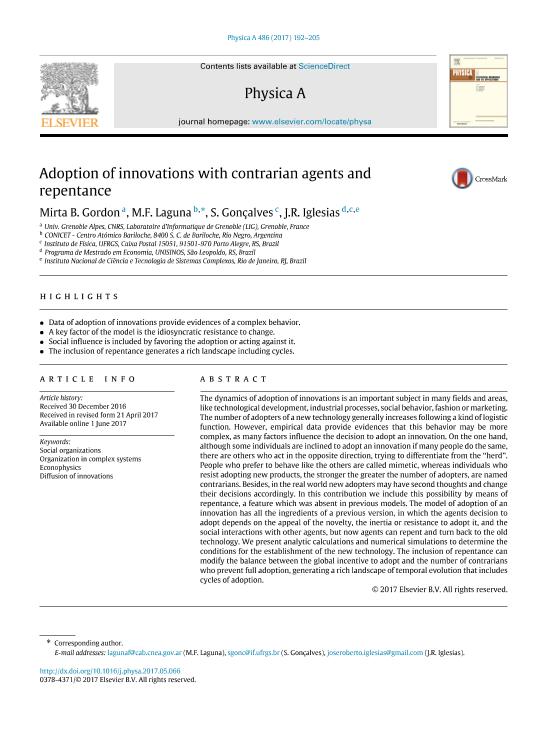Mostrar el registro sencillo del ítem
dc.contributor.author
Gordon, Mirta B.
dc.contributor.author
Laguna, Maria Fabiana

dc.contributor.author
Gonçalves, S.
dc.contributor.author
Iglesias, José Roberto

dc.date.available
2018-01-09T18:48:33Z
dc.date.issued
2017-06
dc.identifier.citation
Gonçalves, S.; Laguna, Maria Fabiana; Gordon, Mirta B.; Iglesias, José Roberto; Adoption of innovations with contrarian agents and repentance; Elsevier Science; Physica A: Statistical Mechanics and its Applications; 486; 6-2017; 192-205
dc.identifier.issn
0378-4371
dc.identifier.uri
http://hdl.handle.net/11336/32700
dc.description.abstract
The dynamics of adoption of innovations is an important subject in many fields and areas, like technological development, industrial processes, social behavior, fashion or marketing. The number of adopters of a new technology generally increases following a kind of logistic function. However, empirical data provide evidences that this behavior may be more complex, as many factors influence the decision to adopt an innovation. On the one hand, although some individuals are inclined to adopt an innovation if many people do the same, there are others who act in the opposite direction, trying to differentiate from the “herd”. People who prefer to behave like the others are called mimetic, whereas individuals who resist adopting new products, the stronger the greater the number of adopters, are named contrarians. Besides, in the real world new adopters may have second thoughts and change their decisions accordingly. In this contribution we include this possibility by means of repentance, a feature which was absent in previous models. The model of adoption of an innovation has all the ingredients of a previous version, in which the agents decision to adopt depends on the appeal of the novelty, the inertia or resistance to adopt it, and the social interactions with other agents, but now agents can repent and turn back to the old technology. We present analytic calculations and numerical simulations to determine the conditions for the establishment of the new technology. The inclusion of repentance can modify the balance between the global incentive to adopt and the number of contrarians who prevent full adoption, generating a rich landscape of temporal evolution that includes cycles of adoption.
dc.format
application/pdf
dc.language.iso
eng
dc.publisher
Elsevier Science

dc.rights
info:eu-repo/semantics/openAccess
dc.rights.uri
https://creativecommons.org/licenses/by-nc-nd/2.5/ar/
dc.subject
Diffusion of Innovations
dc.subject
Econophysics
dc.subject
Organization in Complex Systems
dc.subject
Social Organizations
dc.subject.classification
Astronomía

dc.subject.classification
Ciencias Físicas

dc.subject.classification
CIENCIAS NATURALES Y EXACTAS

dc.title
Adoption of innovations with contrarian agents and repentance
dc.type
info:eu-repo/semantics/article
dc.type
info:ar-repo/semantics/artículo
dc.type
info:eu-repo/semantics/publishedVersion
dc.date.updated
2017-12-15T14:31:25Z
dc.journal.volume
486
dc.journal.pagination
192-205
dc.journal.pais
Países Bajos

dc.journal.ciudad
Amsterdam
dc.description.fil
Fil: Gordon, Mirta B.. University Grenoble; Francia
dc.description.fil
Fil: Laguna, Maria Fabiana. Comisión Nacional de Energía Atómica. Centro Atómico Bariloche; Argentina. Consejo Nacional de Investigaciones Científicas y Técnicas; Argentina
dc.description.fil
Fil: Gonçalves, S.. Universidade Federal do Rio Grande do Sul; Brasil
dc.description.fil
Fil: Iglesias, José Roberto. Universidade Federal do Rio Grande do Sul; Brasil. Universidade do Vale do Rio dos Sinos; Brasil. Instituto Nacional de Ciência e Tecnologia de Sistemas Complexos; Brasil. Consejo Nacional de Investigaciones Científicas y Técnicas; Argentina
dc.journal.title
Physica A: Statistical Mechanics and its Applications

dc.relation.alternativeid
info:eu-repo/semantics/altIdentifier/doi/http://dx.doi.org/10.1016/j.physa.2017.05.066
dc.relation.alternativeid
info:eu-repo/semantics/altIdentifier/url/http://www.sciencedirect.com/science/article/pii/S037843711730585X
Archivos asociados
